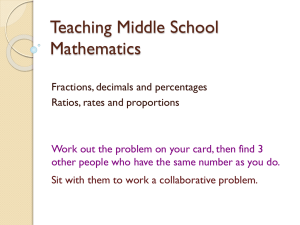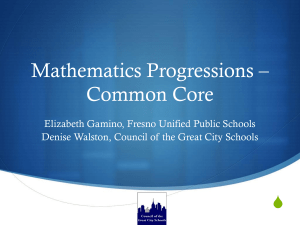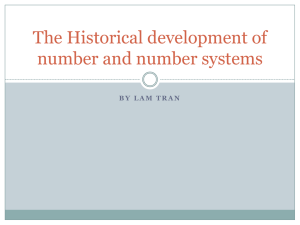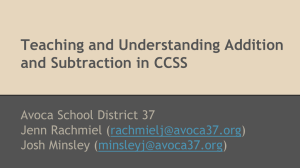SLO Turnkey - Department of Assessment, Research & Evaluation
advertisement
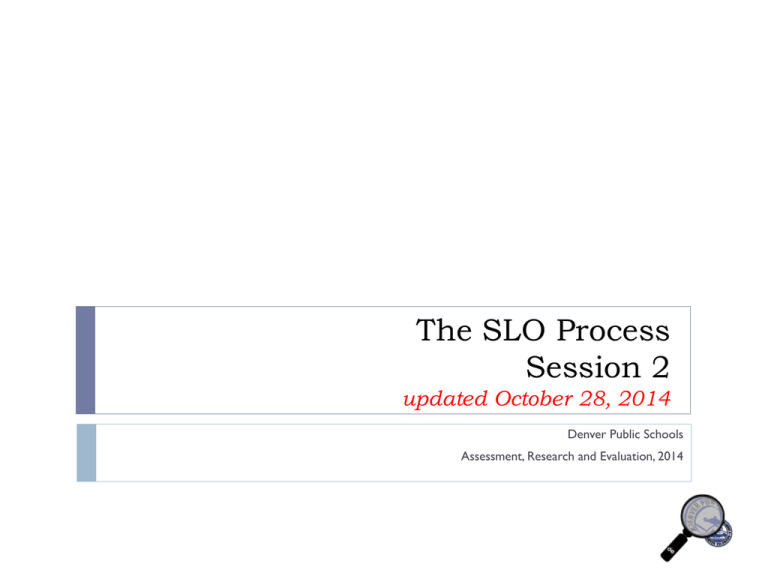
The SLO Process Session 2 updated October 28, 2014 Denver Public Schools Assessment, Research and Evaluation, 2014 Objectives Learn to create an Objective Statement Learn to determine Performance Criteria Learn to develop corresponding Rubric Learn to determine appropriate sources of Baseline Data in order to categorize students’ preparedness levels Review: What is the Student Learning Objective (SLO) Process? An improved process for DPS educators to set ambitious learning goals for students and measure their progress toward attaining them Two core elements of an SLO: 1. determine what is most important for students to learn by the end of the year and 2. measure student progress toward that goal throughout the year. First steps 1. 2. 3. 4. Select what is most important for your student to know by the end of the year. (Objective Statement) Determine what it “looks like” when students reach the objective. (Performance Criteria) Specify varying levels that students reach on their path toward meeting and exceeding the Objective. (Rubric) Gather data to determine students’ preparedness levels as they relate to the Objective. (Baseline Data) The Objective Statement The Objective Statement is comprised of standard(s) and/or grade level expectation(s) and is a general description of what students will know and be able to do at the end of the course. It includes at least one language domain (reading, writing, speaking, listening) and at least one language function (justify, explain, critique, etc.). Suggested Resources for Writing Objective Statements Standards: CCSS, CAS, WIDA, NextGen, CTE, etc. DPS ELGs, Scope and Sequence , Assessment Blueprints CMAS Assessment Framework, PARCC Blueprints Sample Objective Statements and Performance Criteria Teaching & Learning has identified Year-long Focus Standards for literacy, mathematics, social studies and science. Located at testing.dpsk12.org/resources/SLO.html SLO Handbook, Content Considerations Your school’s UIP (if available) Sample - Selecting Standards ELG.MA.4.NF.A: Extend understanding of fraction equivalence and ordering. (Major Cluster) N.F.A.1: Explain why a fraction a/b is equivalent to a fraction (n × a)/(n × b) by using visual fraction models, with attention to how the number and size of the parts differ even though the two fractions themselves are the same size. Use this principle to recognize and generate equivalent fractions. N.F.A.2: Compare two fractions with different numerators and different denominators, e.g., by creating common denominators or numerators, or by comparing to a benchmark fraction such as 1/2. Recognize that comparisons are valid only when the two fractions refer to the same whole. Record the results of comparisons with symbols >, =, or <, and justify the conclusions, e.g., by using a visual fraction model. CCSS.MATH.PRACTICE.3: Construct viable arguments and critique the reasoning of others CCSS.MATH.PRACTICE.6: Attend to precision Selecting Standards – Examining Vertical Progression Standards for grade(s) from the year(s) before Standards for my Grade(s) and Content Area(s) Standards for grade(s) for the year(s) after CCSS.MATH.CONTENT.3.NF.A.1 Understand a fraction 1/b as the quantity formed by 1 part when a whole is partitioned into b equal parts; understand a fraction a/b as the quantity formed by a parts of size 1/b. ELG.MA.4.NF.A: Extend understanding of fraction equivalence and ordering. (Major Cluster) CCSS.MATH.CONTENT.5.NF.A.1 Add and subtract fractions with unlike denominators (including mixed numbers) by replacing given fractions with equivalent fractions in such a way as to produce an equivalent sum or difference of fractions with like denominators. CCSS.MATH.CONTENT.3.NF.A.2 Understand a fraction as a number on the number line; represent fractions on a number line diagram. CCSS.MATH.CONTENT.3.NF.A.2.A Represent a fraction 1/b on a number line diagram by defining the interval from 0 to 1 as the whole and partitioning it into b equal parts. Recognize that each part has size 1/b and that the endpoint of the part based at 0 locates the number 1/b on the number line. CCSS.MATH.CONTENT.3.NF.A.2.B Represent a fraction a/b on a number line diagram by marking off a lengths 1/b from 0. Recognize that the resulting interval has size a/b and that its endpoint locates the number a/b on the number line CCSS.MATH.PRACTICE.3: Construct viable arguments and critique the reasoning of others CCSS.MATH.PRACTICE.6: Attend to precision N.F.A.1: Explain why a fraction a/b is equivalent to a fraction (n × a)/(n × b) by using visual fraction models, with attention to how the number and size of the parts differ even though the two fractions themselves are the same size. Use this principle to recognize and generate equivalent fractions. N.F.A.2: Compare two fractions with different numerators and different denominators, e.g., by creating common denominators or numerators, or by comparing to a benchmark fraction such as 1/2. Recognize that comparisons are valid only when the two fractions refer to the same whole. Record the results of comparisons with symbols >, =, or <, and justify the conclusions, e.g., by using a visual fraction model. CCSS.MATH.PRACTICE.3: Construct viable arguments and critique the reasoning of others CCSS.MATH.PRACTICE.6: Attend to precision CCSS.MATH.CONTENT.5.NF.A.2 Solve word problems involving addition and subtraction of fractions referring to the same whole, including cases of unlike denominators, e.g., by using visual fraction models or equations to represent the problem. Use benchmark fractions and number sense of fractions to estimate mentally and assess the reasonableness of answers. CCSS.MATH.PRACTICE.3: Construct viable arguments and critique the reasoning of others CCSS.MATH.PRACTICE.6: Attend to precision Sample - Objective Statement All students will be able to compare fractions, with like or unlike numerators and denominators, record the results using symbols, justify the conclusions orally and in writing, and solve simple word problems requiring fraction comparison. Performance Criteria and Rubric The Performance Criteria are a collection of 3-6 clear, specific, and measurable statements that describe how students will demonstrate that they have reached the Objective Statement. The corresponding Rubric defines the various levels of development that students move through as they progress toward the Objective. Suggested Resources for Performance Criteria and Rubric Standards (used in Objective Statement) WIDA Can Do Descriptors PARCC Performance Level Descriptors Curriculum Existing rubrics Objective Statement Performance Criteria All students will be able to compare fractions, with like or unlike numerators and denominators, record the results using symbols, justify the conclusions orally and in writing, and solve word problems requiring fraction comparison. 1. 2. 3. 4. Students will compare fractions, with like or unlike numerators and denominators, by creating equivalent fractions with common denominators, or comparing to a benchmark fraction and generating equivalent fractions. Students will demonstrate the use of conceptual understanding of fractional equivalence and ordering when solving simple word problems requiring fraction comparison. Students will use symbols and academic language to express the results orally and in writing. Students will use a logical progression of steps and academic language to justify their conclusions orally and in writing. Corresponding Rubric Limited/Partial Command Moderate Command Strong Command (Performance Criteria column) Distinguished Command Students will sometimes able to compare fractions, with like or unlike numerators and denominators, by creating a visual model and/or using manipulatives. Students will compare fractions, with like or unlike numerators and denominators, by creating a visual model and/or using manipulatives. Students will compare fractions, with like or unlike numerators and denominators, by creating equivalent fractions with common denominators, or comparing to a benchmark fraction and generating equivalent fractions. Students will compare fractions, with like or unlike numerators and denominators, by creating equivalent fractions with common denominators, and comparing to a benchmark fraction and generating equivalent fractions. Students will solve simple word problems requiring fraction comparison with support and scaffolding. Students will solve simple word problems requiring fraction comparison. Students will be able to create and solve a word problem involving fractional comparisons. Students will use symbols or academic language with varied success to express the results orally or in writing. Students will use symbols and some academic language to express the results orally and in writing with scaffolding. Students will demonstrate the use of conceptual understanding of fractional equivalence and ordering when solving simple word problems requiring fraction comparison. Students will use symbols and academic language to express the results orally and in writing. Students will use an incomplete or illogical progression of steps to justify their conclusions orally or in writing without significant scaffolding and support. Students will use a logical, but incomplete progression of steps and some academic language to justify their conclusions orally or in writing. Students will use a logical progression of steps and academic language to justify their conclusions orally and in writing. Students will use an efficient and logical progression of steps and academic language to justify their conclusions orally or in writing. Students will use symbols and precise academic language to express the results orally and in writing. “Phase 1” for the SLO Application Objective Statement, Performance Criteria and other relevant information Submit Phase 1 for each SLO by October 31 https://slo.dpsk12.org School Leaders Teachers SLO Timeline 2014-15 *Gain familiarity with the SLO process Aug Present SLO overview to teachers *Create 2 Objective Statements Sept *Determine Performance Criteria and Rubric *Collect Baseline Data *Submit Phase 1 using SLO application Oct Ensure access to SLO Application *Analyze Baseline Data and categorize students’ Baseline Preparedness Levels Nov Approve Phase 1 *Plan and Collect Body of Evidence, monitor progress, and adjust instruction accordingly Dec *Collect Body of Evidence, monitor progress, and adjust instruction accordingly *Submit Phase 2 using SLO application Jan *Collect Body of Evidence, monitor progress, and adjust instruction accordingly Feb *Collect Body of Evidence, monitor progress, and adjust instruction accordingly Mar Approve Phase 2 Ongoing Data Team Guidance and Support *Collect Body of Evidence, monitor progress, and adjust instruction accordingly Apr *Evaluate and reflect on student growth *Submit Phase 3 using SLO Application May Submit ratings Looking ahead: Baseline Data How prepared are my students to learn the content in my Objective? Baseline data are sources of data with items and/or tasks that indicate students’ levels of preparedness as they relate to the Objective Statement Include at least two different sources of Baseline Data for each Objective. E.g. previous year’s EOY Interim, TCAP, current performance in the SLO content area Baseline data should be designed/selected collaboratively and scored using a common scoring rubric, if possible. Baseline Preparedness Levels Using information from Baseline Data Sources, students should be categorized based on the following Preparedness Levels: Underprepared: Students who enter the course/grade one or more course/grade levels behind in the prerequisite standards. Somewhat Prepared: Students who enter the course/grade less than one year behind in the prerequisite standards. Prepared: Students who enter the course/grade with command of the prerequisite standards. Ahead: Students who enter the course/grade with a deep command of the prerequisite standards. These students are able to apply previous learning to a variety of contexts. Questions? Visit: http://testing.dpsk12.org/resources/SLO.html Email: slohelp@dpsk12.org

